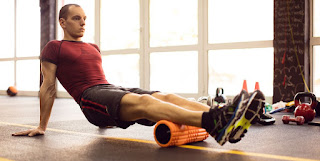1. Cool down
The last thing you want to do after a hard workout is to put in even more effort or work, but that’s exactly what you should do. Take at least five to six minutes to focus on your breath as you stretch out the major muscles you just worked.
Stretching eases muscle tension, enhances blood flow, boosts mobility, and promotes the delivery of oxygen and nutrients to tired muscles, which all help facilitate repair and recovery, helping your body grow stronger.
2. Drink up
It’s important to replenish your body’s water supply after you’ve exerted yourself and sweat so much of it out. Besides lubricating joints to help ward off aches, proper hydration also helps regulate body temperature and prevent muscle cramps and dizziness. Plus, you need enough flow to shuttle all the nutrients that promote recovery to your muscles, heart, brain, and more.
And don’t forget to sip on water before and during your workout, too. If you only drink when you feel thirsty like so many people do, you’re already overexerted and on the spectrum of dehydration. Your body also absorbs it better when you sip over longer periods of time as opposed to guzzling a bunch right after exercise.
3. Give yourself a massage
Foam rolling feels really good, and that’s because it’s essentially a massage. Using a foam roller helps break up muscle “adhesions” that can cause soreness or inhibit performance.
A massage gun can help in a similar way, and if you don’t have either, a lacrosse or tennis ball can do the trick. Follow the product instructions for use, and if using a DIY method, have a personal trainer or physical therapist demonstrate the right way to do it.
4. Feel the chill
There’s a reason athletes regularly soak in an ice bath (yes, a tub filled with ice-cold water!). Hydrotherapy has been shown to reduce inflammation and improve blood flow, two key components to recovery.
If you’re not quite ready for an official ice bath, that’s okay— the same benefits can be absorbed through taking a cold shower!
5. Try compression garments
You can find snug-fitting compression garments for most major body parts—calves, knees, hands, elbows, back, you name it—and they help tame or prevent pain and delayed soreness by slightly squeezing muscles to improve circulation and reduce inflammation.
They are also thought to help remove lactic acid—which builds up in muscles following high-energy exercise, leading to pain—especially in runners. Beyond improving comfort, relieving or preventing pain helps you stay on track with your health goals and promotes improved flexibility and range of motion.
6. Schedule rest
Of course, you take a breather after a workout, but you should designate specific days during the week where you don’t do much at all. A lot of times the mindset is that you need to workout constantly to reach your goals. But seven days a week is too much—your muscles need time to repair in order to get stronger and grow, so build rest days into your exercise regimen.
That doesn’t mean lounge around (sorry!). Doing some light activity that gets your body moving—like a walk, hike, bike ride, light swim, or game of tag—enhances muscle recovery without straining them by boosting blood flow.
7. Do a quick body check
When you’re done working out, take a moment to assess how you feel. One of the best ways to keep soreness or injury at bay is to not overexert yourself. Your goal should be to challenge yourself without punishing yourself. In other words, go hard, but not so hard that you pay the price with soreness the next day. You’ll know you hit the sweet spot if you walk away from your workout feeling challenged, but also strong and energized. You should never leave a workout feeling drained and spent. If you do, dial it back next time.
8. Feed your muscles
In order to build muscle strength or bigger muscles in general, pay close attention to the foods you eat after exercise. It’s best practice to eat something within an hour of completing your workout.
Savage recommends eating a balance of healthy carbs, lean protein, and healthy fat—all of which help facilitate the changes your body needs to make physical progress. For example, a slice of whole grain toast with peanut butter and sliced bananas or a cup of Greek yogurt with fresh berries would fit the bill.
It’s also important to replenish the electrolytes lost through sweating. These minerals play an essential role in fluid regulation and muscle contraction—and lacking in them can lead to muscle cramps or weakness, dizziness, a headache, and other unpleasant symptoms. Most fresh fruit contains electrolytes, and sipping on coconut water is also a good way to boost your levels.
9. Get hot, then cold
When you’re feeling sore after a tough workout, apply heat to help relax and calm muscles, then switch to ice to reduce pain and inflammation. This combo is ideal—then stretch out your muscle.
10. Prioritize sleep
Bedtime is when our muscles get the chance to recover from exercise, and sleep deprivation prevents protein synthesis needed to repair your muscles.
Create a sleep routine that helps you doze off. In order to sleep soundly all night we recommend creating a soothing ritual, which can include practicing a quick meditation, dimming the lights, or diffusing a relaxing scent like lavender.

No comments:
Post a Comment